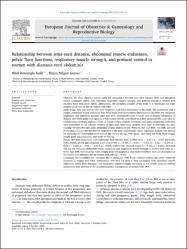| dc.contributor.author | Külli Denizoğlu, Hilal | |
| dc.contributor.author | Gurses, Hulya Nilgun | |
| dc.date.accessioned | 2023-11-25T13:07:28Z | |
| dc.date.available | 2023-11-25T13:07:28Z | |
| dc.date.issued | 2022 | en_US |
| dc.identifier.citation | Denizoglu Kulli, H., & Gurses, H. N. (2022). Relationship between inter-recti distance, abdominal muscle endurance, pelvic floor functions, respiratory muscle strength, and postural control in women with diastasis recti abdominis. European journal of obstetrics, gynecology, and reproductive biology, 279, 40–44. https://doi.org/10.1016/j.ejogrb.2022.10.001 | en_US |
| dc.identifier.uri | https://hdl.handle.net/20.500.12900/209 | |
| dc.description.abstract | Objective: The main objective was to assess the relationship between inter-recti distance (IRD) and abdominal
muscle endurance, pelvic floor functions, respiratory muscle strength, and postural control in women with
Diastasis Recti Abdominis (DRA). Additionally, the secondary purpose of the study is to investigate the independent predictors of IRD in women with DRA.
Study design: Fifty-one women who were diagnosed with DRA participated to the study. IRD assessment with a
caliper, abdominal muscle endurance test, Pelvic Floor Distress Inventory Questionnaire-20 (PFDI-20), maximum
inspiratory and expiratory pressure (MIP and MEP, respectively) tests, Clinical Test of Sensory Integration of
Balance (m-CTSIB) under eyes open on a firm surface (EOFS), eyes closed on a firm surface (ECFS), eyes open on
a foam surface (EOFoS), and eyes closed on a foam surface (ECFoS) conditions, and Limits of Stability (LOS) tests
were performed for all subjects. Pearson or Spearman correlation analyses were used to determine the relationship between IRD and static abdominal flexion endurance test, PFDI-20, MIP and MEP, m-CTSIB, and LOS
scores depending on the distribution properties of the data. Additionally, linear regression analysis was utilized
for analyzing the independent predictors of IRD among the age, BMI, parity, time since last birth, birth weight,
weight gains last pregnancy, and mode of delivery.
Results: IRD had correlations with Colorectal–Anal Distress score of PFDI-20 (r = -0.317, p = 0.03) and EOFS,
ECFS, EOFoS, ECFoS and composite score of m-CTSIB (r = 0.356, p = 0.01; r = 0.337, p = 0.02, r = 0.279, p =
0.04; r = 0.265, p = 0.04; r = 0.413, p = 0.004, respectively) and LOS scores (r = 0.422, p = 0.003). Increased
IRD did not influence abdominal muscle endurance and respiratory muscle strength in women with DRA (p <
0.05). Age, BMI, time since last birth, weight gains last pregnancy, and mode of delivery were not determined as
the factors that influence IRD in women with DRA (p < 0.05).
Conclusion: We concluded that increased IRD is associated with worse postural control, but better colorectal
functions in women with DRA. Additionally, IRD does not show a clear association with abdominal muscle
endurance, pelvic floor functions, and respiratory muscle strength. According to our results, postural stability
assessments may perform in the physiotherapeutic management of women with DRA. | en_US |
| dc.language.iso | eng | en_US |
| dc.publisher | Elsevier | en_US |
| dc.relation.isversionof | Hilal Denizoğlu Külli / 0000-0002-8003-4440 | en_US |
| dc.rights | info:eu-repo/semantics/openAccess | en_US |
| dc.subject | Karın dayanıklılığı | en_US |
| dc.subject | Abdominal endurance | en_US |
| dc.subject | Diastaz rekti abdominis | en_US |
| dc.subject | Diastasis recti abdominis | en_US |
| dc.subject | Pelvik taban disfonksiyonu | en_US |
| dc.subject | Pelvic floor dysfunction | en_US |
| dc.subject | Postüral kontrol | en_US |
| dc.subject | Postural control | en_US |
| dc.subject | Solunum kas gücü | en_US |
| dc.subject | Respiratory muscle strength | en_US |
| dc.title | Relationship between inter-recti distance, abdominal muscle endurance, pelvic floor functions, respiratory muscle strength, and postural control in women with diastasis recti abdominis | en_US |
| dc.type | article | en_US |
| dc.department | İstanbul Atlas Üniversitesi, Lisansüstü Eğitim Enstitüsü, Fizyoterapi ve Rehabilitasyon Ana Bilim Dalı | en_US |
| dc.authorid | 0000-0002-8003-4440 | en_US |
| dc.contributor.institutionauthor | Külli Denizoğlu, Hilal | |
| dc.identifier.volume | 29 | en_US |
| dc.identifier.startpage | 40 | en_US |
| dc.identifier.endpage | 44 | en_US |
| dc.relation.journal | European Journal of Obstetrics & Gynecology and Reproductive Biology | en_US |
| dc.relation.publicationcategory | Makale - Uluslararası Hakemli Dergi - Kurum Öğretim Elemanı | en_US |

















